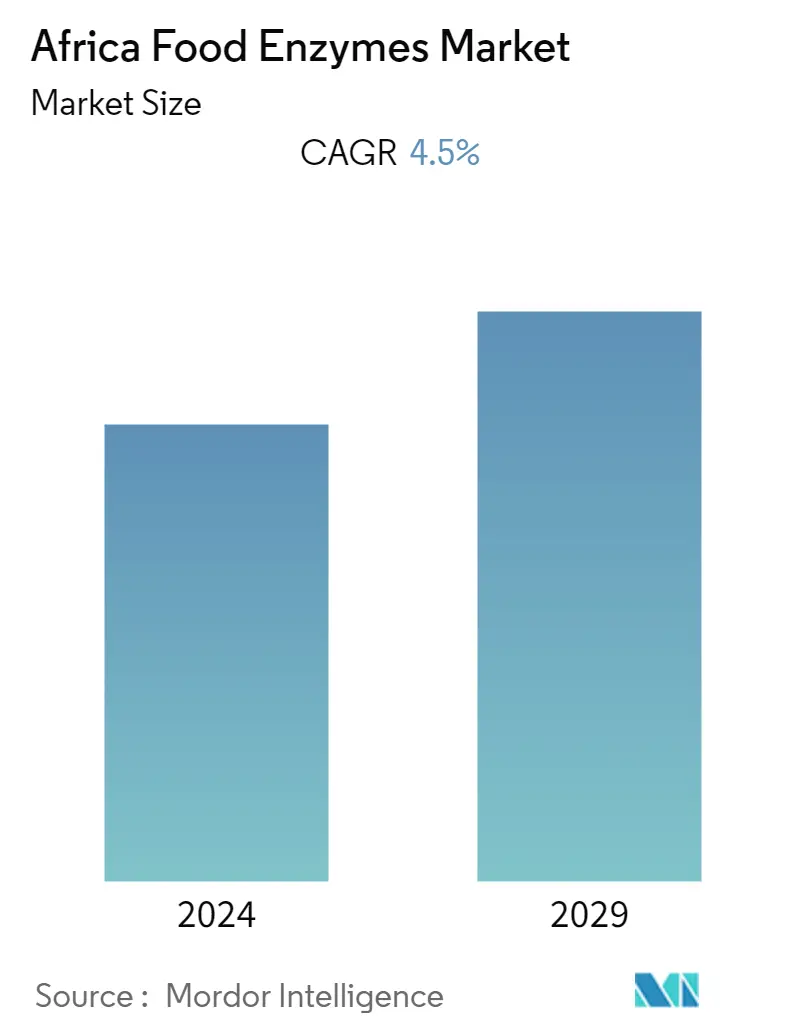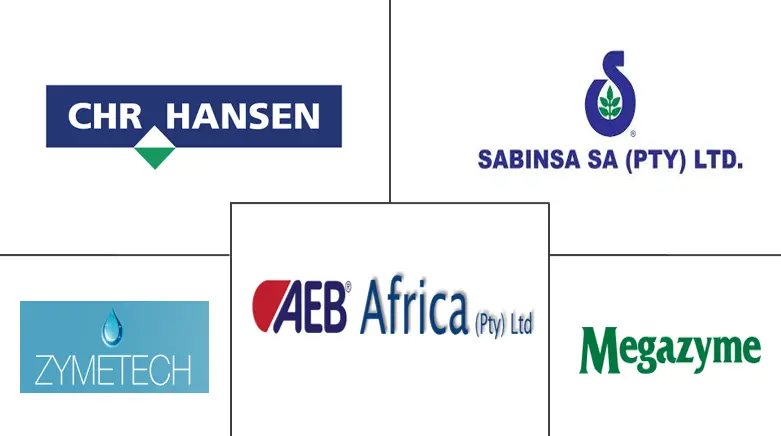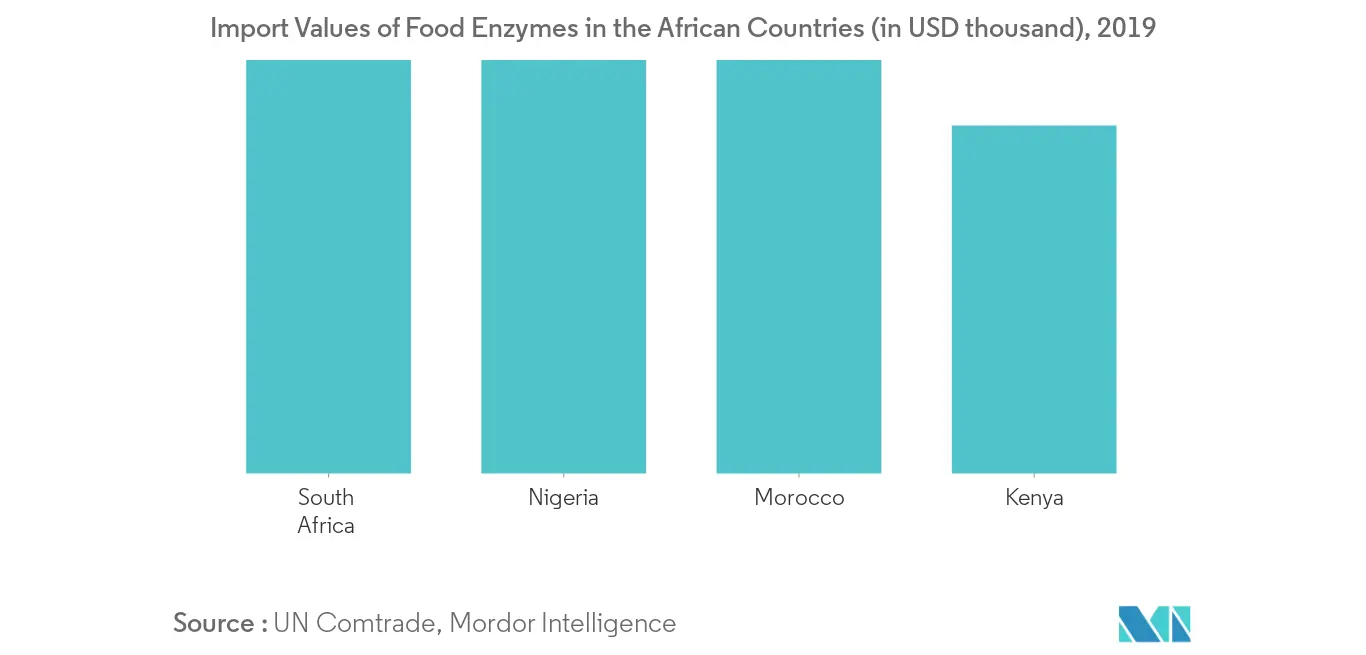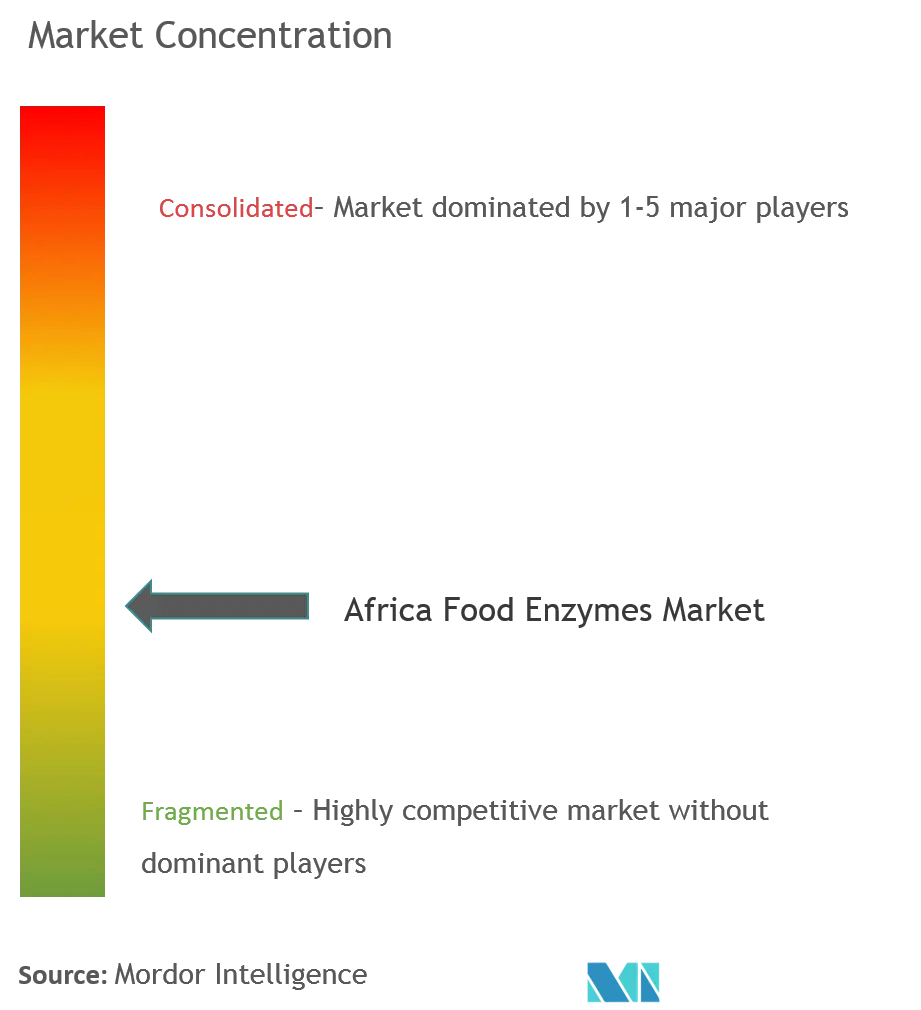Africa Food Enzymes Market Size

| Study Period | 2019 - 2029 |
| Base Year For Estimation | 2023 |
| Forecast Data Period | 2024 - 2029 |
| Historical Data Period | 2019 - 2022 |
| CAGR | 4.50 % |
| Market Concentration | Medium |
Major Players
*Disclaimer: Major Players sorted in no particular order |
Africa Food Enzymes Market Analysis
The African food enzymes market is forecasted to grow at a CAGR of 4.5% during the forecast period (2020 - 2025).
The food enzyme market is witnessing rapid growth due to the increasing demand for processed food and wide applications of the enzymes in the processed food industry in the region. Innovation in food technology in the region and the growing awareness about better-quality products being manufactured, by utilizing enzymes are the other factors that are further driving the market growth. For instance, genetically modified enzymes, which are usually associated with health effects in the long-term, has resulted in a setback for the growth of the industry. However, as the food safety authorities are issuing standards for enzyme consumption, the consumers have started accepting the products treated with genetically-modified enzymes.
Africa Food Enzymes Market Trends
This section covers the major market trends shaping the Africa Food Enzymes Market according to our research experts:
Acquisitive Demand of Carbohydrases in Food Industries
Carbohydrases can be classified into amylase, cellulase, xylanase, and pectinase, based on the specific class of carbohydrase that is required to break down the cell walls of different plants, made up of different structural carbohydrates. These facilitate the formation of different types of sugar syrups, such as glucose, fructose, and inverted sugar syrups, prebiotics, and isomaltulose, a substitute for sucrose, to improve the sensory properties of juices and wines and to reduce lactose in milk. Industrial carbohydrase used in the manufacturing of food products helps to increases the energy value of cereals and cereal by-products, improve nutrient release in full-fat vegetable protein seeds and in vegetable protein meals, enhance the digestibility of starch in corn-based diets, and increase the utilization of corn, especially amylase, in dairy diets, thus improving the efficiency of milk production.
Owing to its increasing application in food industries, nowadays, companies have established their own R&D centers to cater to the needs of the industry and thus remain competitive in the market. For instance, enzyme manufacturers of Africa have developed innovative thermostable enzymes, which are free-flowing and result in reduced waste generation as well. These factors have also resulted into the rising imports of enzymes for its usage in food and beverage industries in the country.

South Africa to Hold the Major Share
South Africa has one of the largest and most well-established food enzyme markets in the Africa region. The large demand is attributed to the increased expenditure in premium quality products by the consumers of South Africa, along with the shift in preference for processed foods incorporated with naturally sourced ingredients. Furthermore, the government's support, through enabling policies, has positively impacted the growth of the food enzyme market in the country. Many South African companies have formed associations with international companies, giving South Africa access to the latest technology, expertise, and distribution. For instance, In August 2019, Barentz International, a leading global distributor of a comprehensive portfolio of specialty ingredients (including food enzymes), announced a joint venture with SK Chemtrade Services, to continue its expansion in South Africa.
Moreover, technological innovation and upgradations of the South African-based companies and the global companies having manufacturing facilities in South Africa are the few other key driving factors for market growth in the country. In addition, rapid urbanization coupled with rising living standards are also anticipated to be the drivers for change in consumer taste and preferences in the South Africa.

Africa Food Enzymes Industry Overview
The Africa food enzymes market is competitive and fragmented in nature having a large number of domestic and multinational players competing for market share. Emphasis is given on the merger, expansion, acquisition, and partnership of the companies along with new product development as strategic approaches adopted by the leading companies to boost their brand presence among consumers. Key players dominating the regional market include Chr. Hansen Holding AS, DuPont de Nemours Inc., and Sabinsa South Africa (Pty) Ltd., among others.
Africa Food Enzymes Market Leaders
-
Chr. Hansen Holding AS
-
Sabinsa South Africa (Pty) Ltd.
-
Zymetech
-
AEB Africa (PTY) LTD
-
Megazyme Ltd.
*Disclaimer: Major Players sorted in no particular order

Africa Food Enzymes Market Report - Table of Contents
1. INTRODUCTION
- 1.1 Study Deliverables
- 1.2 Study Assumptions
- 1.3 Scope of the Study
2. RESEARCH METHODOLOGY
3. EXECUTIVE SUMMARY
4. MARKET DYNAMICS
- 4.1 Market Drivers
- 4.2 Market Restraints
-
4.3 Porter's Five Forces Analysis
- 4.3.1 Threat of New Entrants
- 4.3.2 Bargaining Power of Buyers/Consumers
- 4.3.3 Bargaining Power of Suppliers
- 4.3.4 Threat of Substitute Products
- 4.3.5 Intensity of Competitive Rivalry
5. MARKET SEGMENTATION
-
5.1 By Type
- 5.1.1 Carbohydrase
- 5.1.2 Protease
- 5.1.3 Lipase
- 5.1.4 Others
-
5.2 By Application
- 5.2.1 Bakery
- 5.2.2 Confectionery
- 5.2.3 Dairy and Frozen Desserts
- 5.2.4 Meat, Poultry and Sea Food Products
- 5.2.5 Beverages
- 5.2.6 Others
-
5.3 By Country
- 5.3.1 South Africa
- 5.3.2 Kenya
- 5.3.3 Nigeria
- 5.3.4 Rest of Africa
6. COMPETITIVE LANDSCAPE
- 6.1 Most Active Companies
- 6.2 Most Adopted Strategies
- 6.3 Market Share Analysis
-
6.4 Company Profiles
- 6.4.1 Chr. Hansen Holding AS
- 6.4.2 Sabinsa South Africa (Pty) Ltd.
- 6.4.3 Zymetech
- 6.4.4 AEB Africa (PTY) LTD
- 6.4.5 Megazyme Ltd.
- 6.4.6 DuPont de Nemours Inc.
- *List Not Exhaustive
7. MARKET OPPORTUNITIES AND FUTURE TRENDS
** Subject To AvailablityAfrica Food Enzymes Industry Segmentation
The Africa food enzymes market is segmented by type into carbohydrase, protease, lipase, and others. Based on the application, the market is divided into the bakery, confectionery, dairy, and frozen desserts, meat, poultry, and seafood products, beverages, and other industries. Also, the study provides an analysis of the food enzymes market in the emerging and established markets across the globe, including South Africa, Nigeria, Kenya, and the Rest of Africa.
| By Type | Carbohydrase |
| Protease | |
| Lipase | |
| Others | |
| By Application | Bakery |
| Confectionery | |
| Dairy and Frozen Desserts | |
| Meat, Poultry and Sea Food Products | |
| Beverages | |
| Others | |
| By Country | South Africa |
| Kenya | |
| Nigeria | |
| Rest of Africa |
Africa Food Enzymes Market Research FAQs
What is the current Africa Food Enzymes Market size?
The Africa Food Enzymes Market is projected to register a CAGR of 4.5% during the forecast period (2024-2029)
Who are the key players in Africa Food Enzymes Market?
Chr. Hansen Holding AS, Sabinsa South Africa (Pty) Ltd., Zymetech, AEB Africa (PTY) LTD and Megazyme Ltd. are the major companies operating in the Africa Food Enzymes Market.
What years does this Africa Food Enzymes Market cover?
The report covers the Africa Food Enzymes Market historical market size for years: 2019, 2020, 2021, 2022 and 2023. The report also forecasts the Africa Food Enzymes Market size for years: 2024, 2025, 2026, 2027, 2028 and 2029.
Africa Food Enzymes Industry Report
Statistics for the 2024 Africa Food Enzymes market share, size and revenue growth rate, created by Mordor Intelligence™ Industry Reports. Africa Food Enzymes analysis includes a market forecast outlook 2029 and historical overview. Get a sample of this industry analysis as a free report PDF download.



